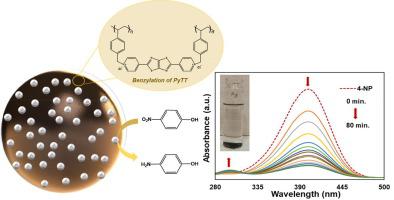European Polymer Journal ( IF 5.8 ) Pub Date : 2022-07-02 , DOI: 10.1016/j.eurpolymj.2022.111391 Zeynep Dikmen , Meliha Işık , Onur Turhan , Melina Akbari , Cansel Tuncer , Roshan Javanifar , Vural Bütün

|
2,5-di(pyridin-4-yl)thiazolo[5,4-d]thiazole (PyTT) molecule was synthesized and used as cross-linker to modify poly(4-vinyl benzylchloride) microparticles (PVBC-MPs) thanks to its superior interaction with 4-vinyl benzyl chloride monomer containing active –Cl atom. PVBC spherical microparticles were successfully synthesized by suspension polymerization method and they were modified via two different approaches as in-situ and post-modification. Monodispersity of particles via in-situ modification is a challenging approach due to the low solubility of PyTT. Therefore, post-modification of PVBC microparticles with PyTT dye was carried out. The particles act as metal nanoreactor in absence of any reducing agent both at room temperature and 50 °C. The particle morphology was determined with electron microscopies before and after reduction process. Metal nanoparticles (MNP) on MPs were characterized via XRD analysis. Gold, silver and platinum nanoparticles (AuNP, AgNP and PtNP) decorated microparticles were successfully synthesized. According to the ICP-MS results, 25.6% Ag, 24.7% Pt and 0.33% Au were found in the microparticles treated with metal cations. These MNP decorated MPs were used as hybrid heterogeneous catalyst for 4-nitrophenol reduction into 4-amino phenol. The highest catalytic efficiency was obtained with AgNPs decorated MPs as also consistent with the ICP-MS data. The catalytic activities of the MNP decorated MPs were determined with time dependent absorption measurents via UV-Vis spectroscopy.
中文翻译:

噻唑并噻唑基染料改性微球作为金属纳米粒子反应器模板和混合催化剂
2,5-二(吡啶-4-基)噻唑并[5,4- d]噻唑 (PyTT) 分子被合成并用作交联剂来修饰聚 (4-乙烯基苄基氯) 微粒 (PVBC-MPs),因为它与含有活性 –Cl 原子的 4-乙烯基苄基氯单体具有优异的相互作用。通过悬浮聚合法成功合成了PVBC球形微粒,并通过原位和后改性两种不同的方法对其进行了改性。由于 PyTT 的溶解度低,通过原位修饰实现颗粒的单分散性是一种具有挑战性的方法。因此,使用 PyTT 染料对 PVBC 微粒进行后修饰。在室温和 50°C 下,颗粒在没有任何还原剂的情况下充当金属纳米反应器。在还原过程之前和之后用电子显微镜测定颗粒形态。MPs上的金属纳米颗粒(MNP)通过XRD分析进行表征。成功合成了金、银和铂纳米粒子(AuNP、AgNP 和 PtNP)装饰的微粒。根据ICP-MS结果,在用金属阳离子处理的微粒中发现了25.6%的Ag、24.7%的Pt和0.33%的Au。这些 MNP 修饰的 MP 被用作混合多相催化剂,用于将 4-硝基苯酚还原为 4-氨基苯酚。使用 AgNPs 修饰的 MPs 获得了最高的催化效率,这也与 ICP-MS 数据一致。MNP 修饰的 MPs 的催化活性通过紫外-可见光谱用时间依赖性吸收测量来确定。在用金属阳离子处理的微粒中发现了 6% Ag、24.7% Pt 和 0.33% Au。这些 MNP 修饰的 MP 被用作混合多相催化剂,用于将 4-硝基苯酚还原为 4-氨基苯酚。使用 AgNPs 修饰的 MPs 获得了最高的催化效率,这也与 ICP-MS 数据一致。MNP 修饰的 MPs 的催化活性通过紫外-可见光谱用时间依赖性吸收测量来确定。在用金属阳离子处理的微粒中发现了 6% Ag、24.7% Pt 和 0.33% Au。这些 MNP 修饰的 MP 被用作混合多相催化剂,用于将 4-硝基苯酚还原为 4-氨基苯酚。使用 AgNPs 修饰的 MPs 获得了最高的催化效率,这也与 ICP-MS 数据一致。MNP 修饰的 MPs 的催化活性通过紫外-可见光谱用时间依赖性吸收测量来确定。







































 京公网安备 11010802027423号
京公网安备 11010802027423号